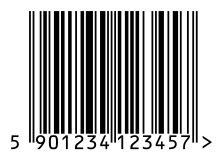The International Article Number (EAN) (also known as European Article Number, which technically refers to EAN-13) is a 13-digit barcode symbology, which is a superset of the original 12-digit Universal Product Code (UPC) (also known as UPC-A), developed in 1970 by George J. Laurer.[1]
The EAN-13 barcode is used worldwide for marking products often sold at retail point of sale. It encapsulates 2-digit or 3-digit number system (GS1 Prefix (usually GS1 country code)), in contrast with UPC-A's 1-digit number system. EAN-13 barcode with number system 45 or 49 is known as Japanese Article Number (JAN). All the numbers encoded in UPC and EAN are part of GTINs, and they can be encoded in other barcodes defined by the GS1 organization.
The less commonly used 8-digit EAN-8 barcode was introduced for use on small packages, where EAN-13 would be too large.
2-digit EAN-2 and 5-digit EAN-5 are supplemental barcodes, placed on the right-hand side of EAN-13 or UPC. These are generally used for periodicals to indicate the current year's issue number, like magazines,[2] or books,[3] and weighed products like food (to indicate the manufacturer's suggested retail price (MSRP)).
Source: From Wikipedia, the free encyclopedia
For full article click here
